It is a practical reality that a drug product is not spontaneously generated at its point of use. Rather, the drug product is manufactured with a system that is designed and constructed for this purpose. Although the manufacturing process may vary somewhat across drug products and drug product vendors, the process generally consists of steps that perform the following functions:
- Synthesis of the drug substance (active pharmaceutical ingredient) and excipients,
- Processing and formulation of the drug product from its drug substance(s) and excipients,
- Sterilization of the drug product, and
- Packaging of the sterilized drug product (note that steps 3 and 4 may be performed in different orders and in different manners).
During the manufacturing process, the precursor solution to the drug product (termed the process stream) contacts the materials and components that make up the manufacturing equipment. Since these components (filters, filter housings, tubing, disposable bioreactors, storage bags, mixing systems, disposable lyophilization trays, impellers, connectors, chromatographic columns and column housings, etc.) are not chemically inert, the process stream will interact with the components.
As is the case with packaging, this interaction can cause substances to be leached out of the components. If these substances persist through the manufacturing process, they will become foreign impurities in the packaged drug product, where they could have the same potential adverse effects on the drug product’s suitability for use as would packaging-related leachables. Foreign impurities derived from manufacturing are termed process equipment-related leachables (PerLs) to differentiate them from leachables derived from packaging.
As is the case with packaging, this interaction can cause substances to be leached out of the components. If these substances persist through the manufacturing process, they will become foreign impurities in the packaged drug product, where they could have the same potential adverse effects on the drug product’s suitability for use as would packaging-related leachables. Foreign impurities derived from manufacturing are termed process equipment-related leachables (PerLs) to differentiate them from leachables derived from packaging.
Although it is a global regulatory requirement that manufacturing systems be inert (for example, the requirement in 21 CFR part 211.65 that “Equipment shall be constructed so that surfaces that contact components, in-process materials, or drug product shall not be reactive, additive or absorptive so as to alter the safety, identity, strength, quality or purity of the drug product beyond the official or other established requirements…”), it is well known that inertness in its absolute sense cannot be achieved. Thus, relative inertness must be demonstrated by establishing that the magnitude of interaction between a manufacturing system and the process stream is such that PerLs present in manufactured drug products do not adversely affect the product’s suitability for intended use.
Even though it is not a regulatory requirement, relative inertness must also be demonstrated by establishing that the efficiency of the manufacturing process is not lessened by substances leaching into the process stream.
Although the regulations establish the necessity for the chemical assessment of manufacturing equipment, they do not establish the means for performing such an assessment. To bridge this gap, various industry groups [for example, component vendors (the BioProcess Systems Alliance, BPSA) and component users (BioPhorum Operations Group, BPOG)] have published good practice recommendations and the USP is in the processing of drafting both enforceable and informational monographs (<665> and <1665> respectively) on the selection and qualification of materials and components used in manufacturing.
These efforts notwithstanding, designing, implementing, reporting, and interpreting the right chemical assessment for a manufacturing component is neither an intuitive nor trivial matter. Although the chemical assessment might include extractables and leachables testing, proper assessment requires effective risk analysis, prudent and justified testing, and well-thought-out data interpretation.
The practical consequences of a poor chemical assessment are significant, measured in lost time, excessive costs, and delays in securing regulatory approvals. Nelson Labs Europe, with its vast and successful experience in developing, implementing, interpreting, and reporting chemical assessments, including extractables and leachables studies, can devise, execute, and report a customized approach, expertly tailored to address the suitability for use issues specific for a particular application while addressing a particular client’s scientific and practical realities.



